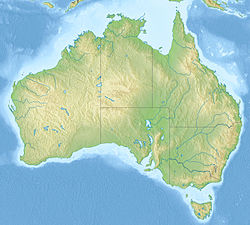| Wonthaggi Formation | |
|---|---|
| Stratigraphic range: | |
 Flat rocks locality | |
| Type | Geological formation |
| Unit of | Strzelecki Group |
| Underlies | Unconformity with Wombat Volcanics & Kersop Arkose |
| Overlies | Paleozoic basement |
| Thickness | Up to 2,500 m (8,200 ft) |
| Lithology | |
| Primary | Volcaniclastic sandstone, siltstone |
| Other | Conglomerate, coal |
| Location | |
| Coordinates | 38°42′S145°42′E / 38.7°S 145.7°E |
| Approximate paleocoordinates | 77°00′S117°30′E / 77.0°S 117.5°E |
| Region | Victoria |
| Country | Australia |
| Extent | Gippsland Basin |
The Wonthaggi Formation is an informal geological formation in Victoria, Australia whose strata date back to the Early Cretaceous. It is part of the Strzelecki Group within the Gippsland Basin. Dinosaur remains are among the fossils that have been recovered from the formation. [1] [2] It is partially equivalent to the Eumeralla Formation.





